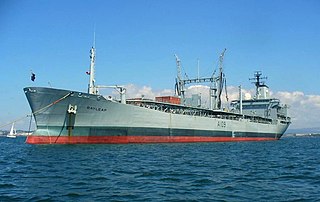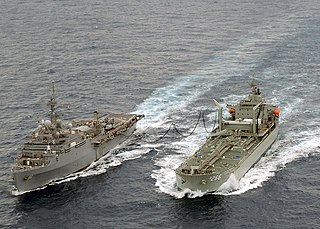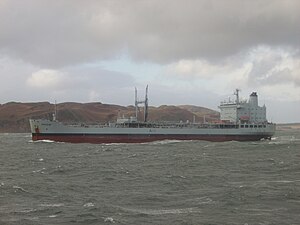
The Royal Fleet Auxiliary (RFA) is a naval auxiliary fleet owned by the UK's Ministry of Defence. It is a component of His Majesty's Naval Service and provides logistical and operational support to the Royal Navy and Royal Marines. The RFA ensures the Royal Navy is supplied and supported by providing fuel and stores through replenishment at sea, transporting Royal Marines and British Army personnel, providing medical care and transporting equipment and essentials around the world. In addition the RFA acts independently providing humanitarian aid, counter piracy and counter narcotic patrols together with assisting the Royal Navy in preventing conflict and securing international trade. They are a uniformed civilian branch of the Royal Navy staffed by British merchant sailors. The RFA is one of five RN fighting arms.

RFA Diligence was a forward repair ship of the Royal Fleet Auxiliary. Launched in 1981 as a support ship for North Sea oil rigs, she was chartered by the British government to support naval activities during the 1982 Falklands War and was later bought outright as a fleet maintenance vessel. She gave assistance to the damaged USS Tripoli and Princeton in the 1991 Gulf War, and to Sri Lanka after the 2005 tsunami. She typically had deployments of 5-8 years in support of the Trafalgar-class submarine on duty east of Suez, with a secondary role as a mothership for British and US minesweepers in the Persian Gulf. Until 2016 Diligence was set to go out of service in 2020. However in August 2016, the UK Ministry of Defence placed an advert for the sale of RFA Diligence. As of 2016 the option for the delivery of future operational maintenance and repair capability for the RFA remained under consideration. However, the 2021 British defence white paper made no specific mention of the need for this capability. In April 2023, it was revealed that the ship was to be scrapped after no suitable buyers materialised, & she was moved out of 3 Basin across to Fareham Trots to await her final journey to the scrapyard.

RFA Fort Austin is a retired British Fort Rosalie-class dry stores ship of the Royal Fleet Auxiliary.

RFA Gold Rover was a small fleet tanker of the Royal Fleet Auxiliary and one of five Rover-class ships that were designed by the Admiralty, all of which were built at the Swan Hunter shipyard.

RFA Bayleaf (A109) was a Leaf-class support tanker of the Royal Fleet Auxiliary.

RFA Fort Rosalie was the lead ship of her class of Royal Fleet Auxiliary fleet replenishment ships. Fort Rosalie was originally named RFA Fort Grange, but was renamed in May 2000 to avoid confusion with the now-decommissioned RFA Fort George. On 31 March 2021, the ship was withdrawn from service.

RFA Grey Rover (A269) was a Rover-class small fleet tanker of the Royal Fleet Auxiliary (RFA). She was decommissioned in 2006.

RFA Black Rover was a Rover-class small fleet tanker of the British Royal Fleet Auxiliary. She was designed to replenish ships underway at sea with fuel, fresh water, and stores in all weather conditions. She had a helicopter deck served by a stores lift and was capable of conducting helicopter replenishment. Displacing 16,160 tonnes, she was powered by twin diesels and has a ship's company of 60.

RFA Green Rover (A268) was a Rover-class fleet support tanker of the Royal Fleet Auxiliary, built by Swan Hunter Shipbuilders on the River Tyne, UK and completed in 1969. After decommissioning in 1992 she was sold to the Indonesian Navy and renamed KRI Arun (903)

The Wave-class tankers are a class of fast fleet tankers in service with the Royal Fleet Auxiliary. The class is tasked with providing fuel, food, fresh water, ammunition and other supplies to Royal Navy vessels around the world. There are two ships in the class, RFA Wave Knight and RFA Wave Ruler. The ships were ordered to replace the aging Ol-class tankers RFA Olna and RFA Olwen. The two vessels have seen service in a number of locations, including anti-drug and hurricane relief operations in the Caribbean Sea, anti-piracy activities around the Horn of Africa, and deterrent patrols in the South Atlantic. As of early 2022, both ships were earmarked for "extended readiness" status.

A replenishment oiler or replenishment tanker is a naval auxiliary ship with fuel tanks and dry cargo holds which can supply both fuel and dry stores during underway replenishment (UNREP) at sea. Many countries have used replenishment oilers.

Underway replenishment (UNREP) or replenishment at sea (RAS) is a method of transferring fuel, munitions, and stores from one ship to another while under way. First developed in the early 20th century, it was used extensively by the United States Navy as a logistics support technique in the Pacific theatre of World War II, permitting U.S. carrier task forces to remain at sea indefinitely.

HMAS Westralia was a modified Leaf-class replenishment oiler which served with the Royal Australian Navy (RAN) from 1989 to 2006. Formerly RFA Appleleaf (A79), she served in with the British Royal Fleet Auxiliary (RFA) from 1975 to 1989. The ship was initially leased to the RAN, then purchased outright in 1994. In 1998, a fire onboard resulted in the deaths of four sailors. Westralia was decommissioned in 2006, and the ship was sold into civilian service for use as a Floating Production Storage and Offloading vessel, under the name Shiraz. However, the ship was laid up in Indonesia until late 2009, when she was sold to a Turkish ship breaking company. Arriving in January 2010, the vessel was scrapped.

The Fort Rosalie or Fort class of fleet replenishment vessel of the British Royal Fleet Auxiliary were designed to replenish Royal Navy taskgroups with various armaments and victualling stores while under way. Unlike the bigger Fort Victoria class, they supply dry stores and not fuel. RFA Fort Rosalie was originally known as Fort Grange but was renamed in 2000 to avoid confusion with the new Fort Victoria-class replenishment oiler RFA Fort George. Both ships were withdrawn from service and later sold in 2021.

The Leaf class is a class of support tanker of the British Royal Fleet Auxiliary (RFA). The class is somewhat unusual as it is an amalgam of various civilian tankers chartered for naval auxiliary use and as such has included many different designs of ship. Leaf names are traditional tanker names in the RFA, and are recycled when charters end and new vessels are acquired. Thus, there have been multiple uses of the same names, sometimes also sharing a common pennant number.

RFA Wave Ruler is a Wave-class fast fleet tanker of the Royal Fleet Auxiliary (RFA) of the United Kingdom tasked with providing fuel, food, fresh water, ammunition and other supplies to Royal Navy vessels around the world.

RFA Wave Knight is a Wave-class fast fleet tanker of the Royal Fleet Auxiliary (RFA) of the United Kingdom tasked with providing fuel, food, fresh water, ammunition and other supplies to Royal Navy vessels around the world.

The Tide-class tanker (formerly the Military Afloat Reach and Sustainability (MARS) project) is a class of four fast fleet tankers that entered service with the British Royal Fleet Auxiliary from 2017. The 37,000 t ships provide fuel, food, fresh water, ammunition and other supplies to Royal Navy vessels around the world. Norway ordered a similar 26,000 t version with a 48-bed hospital and greater solid stores capacity, but reduced liquid capacity; it was delivered in November 2018 as HNoMS Maud two years after originally planned. The two classes are very similar but are not directly comparable due to large variance in capabilities delivered.
In 1989 the Royal Navy was under the direction of the Navy Department in the UK Ministry of Defence. It had two main commands, CINCFLEET and Naval Home Command.


















